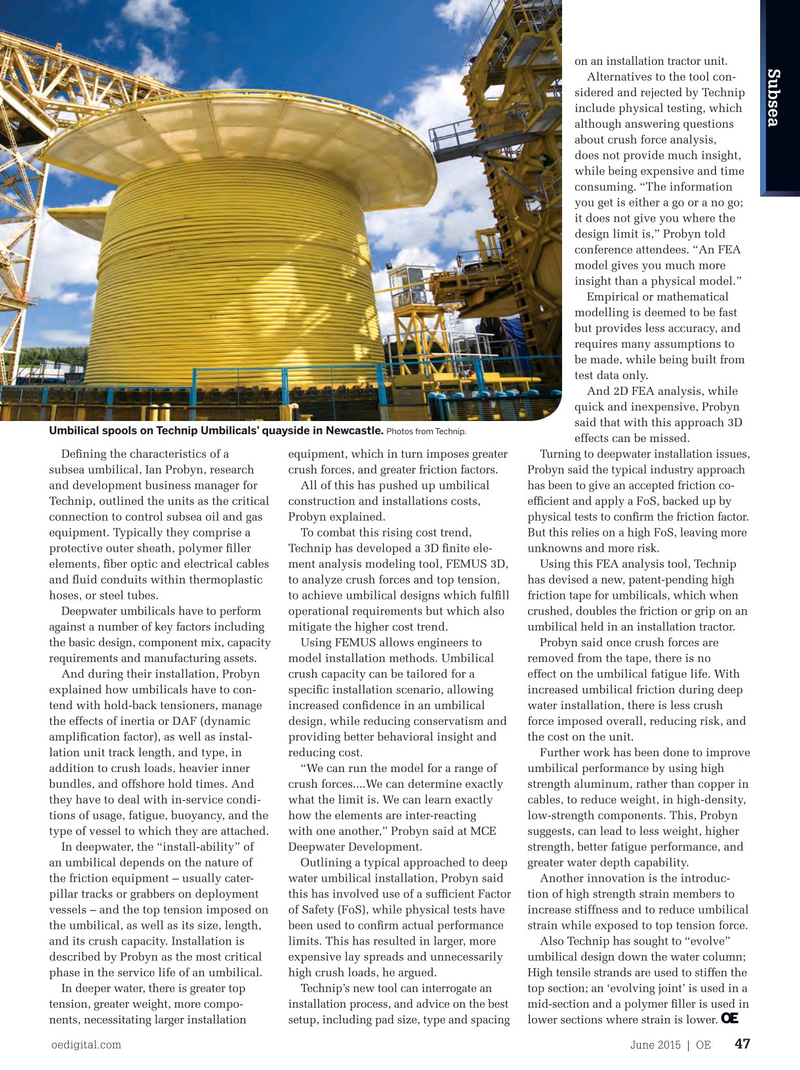
Page 45: of Offshore Engineer Magazine (Jun/Jul 2015)
Read this page in Pdf, Flash or Html5 edition of Jun/Jul 2015 Offshore Engineer Magazine
on an installation tractor unit.
SubseaEyebrow
Alternatives to the tool con- sidered and rejected by Technip include physical testing, which although answering questions about crush force analysis, does not provide much insight, while being expensive and time consuming. “The information you get is either a go or a no go; it does not give you where the design limit is,” Probyn told conference attendees. “An FEA model gives you much more insight than a physical model.”
Empirical or mathematical modelling is deemed to be fast but provides less accuracy, and requires many assumptions to be made, while being built from test data only.
And 2D FEA analysis, while quick and inexpensive, Probyn said that with this approach 3D
Umbilical spools on Technip Umbilicals’ quayside in Newcastle. Photos from Technip.
effects can be missed.
Defning the characteristics of a equipment, which in turn imposes greater
Turning to deepwater installation issues, pipeline was constructed at DeepFlex’s subsea umbilical, Ian Probyn, research crush forces, and greater friction factors.
Probyn said the typical industry approach
Manitowoc, Wisconsin, facility. By the and development business manager for All of this has pushed up umbilical has been to give an accepted friction co- end of this year DeepFlex aims to com- Technip, outlined the units as the critical construction and installations costs, effcient and apply a FoS, backed up by plete all testing. connection to control subsea oil and gas Probyn explained.
physical tests to confrm the friction factor.
Afterwards the company will move equipment. Typically they comprise a To combat this rising cost trend,
But this relies on a high FoS, leaving more into development phase 3a, pipe manu- protective outer sheath, polymer fller Technip has developed a 3D fnite ele- unknowns and more risk.
facturing, involving material procure- elements, fber optic and electrical cables ment analysis modeling tool, FEMUS 3D, Using this FEA analysis tool, Technip ment, manufacturing, procurement of and fuid conduits within thermoplastic to analyze crush forces and top tension, has devised a new, patent-pending high end-fttings and verifcation of ancillary hoses, or steel tubes. to achieve umbilical designs which fulfll friction tape for umbilicals, which when equipment qualifcation and procurement Deepwater umbilicals have to perform operational requirements but which also crushed, doubles the friction or grip on an of bend-stiffeners. A sample has already against a number of key factors including mitigate the higher cost trend. umbilical held in an installation tractor.
been assembled and underwent factory the basic design, component mix, capacity Using FEMUS allows engineers to Probyn said once crush forces are acceptance tests. requirements and manufacturing assets. model installation methods. Umbilical removed from the tape, there is no
Phase 3b is feld deployment, which And during their installation, Probyn crush capacity can be tailored for a effect on the umbilical fatigue life. With involves selection of an installation con- explained how umbilicals have to con- specifc installation scenario, allowing increased umbilical friction during deep tractor and mobilization to the selected tend with hold-back tensioners, manage increased confdence in an umbilical water installation, there is less crush feld. By 2Q 2016 DeepFlex aims to move the effects of inertia or DAF (dynamic design, while reducing conservatism and force imposed overall, reducing risk, and to full manufacturing and feld installa- amplifcation factor), as well as instal- providing better behavioral insight and the cost on the unit.
tion in 4Q 2016. lation unit track length, and type, in reducing cost. Further work has been done to improve addition to crush loads, heavier inner “We can run the model for a range of umbilical performance by using high
Deepwater umbilicals bundles, and offshore hold times. And crush forces....We can determine exactly strength aluminum, rather than copper in
Meanwhile Technip has been working to they have to deal with in-service condi- what the limit is. We can learn exactly cables, to reduce weight, in high-density, cut down the cost of design and deploy- tions of usage, fatigue, buoyancy, and the how the elements are inter-reacting low-strength components. This, Probyn ment of deepwater umbilicals and earlier type of vessel to which they are attached. with one another,” Probyn said at MCE suggests, can lead to less weight, higher this year presented the fruits from its In deepwater, the “install-ability” of Deepwater Development. strength, better fatigue performance, and
Outlining a typical approached to deep research. an umbilical depends on the nature of greater water depth capability.
water umbilical installation, Probyn said the friction equipment – usually cater- Another innovation is the introduc- this has involved use of a suffcient Factor pillar tracks or grabbers on deployment tion of high strength strain members to of Safety (FoS), while physical tests have vessels – and the top tension imposed on increase stiffness and to reduce umbilical been used to confrm actual performance the umbilical, as well as its size, length, strain while exposed to top tension force.
limits. This has resulted in larger, more and its crush capacity. Installation is Also Technip has sought to “evolve” expensive lay spreads and unnecessarily described by Probyn as the most critical umbilical design down the water column; high crush loads, he argued.
phase in the service life of an umbilical. High tensile strands are used to stiffen the
Technip’s new tool can interrogate an
In deeper water, there is greater top top section; an ‘evolving joint’ is used in a installation process, and advice on the best tension, greater weight, more compo- mid-section and a polymer fller is used in setup, including pad size, type and spacing nents, necessitating larger installation lower sections where strain is lower. oedigital.com June 2015 | OE 47 046_OE0615_Subsea1_John.indd 47 6/1/15 12:14 PM

 44
44

 46
46